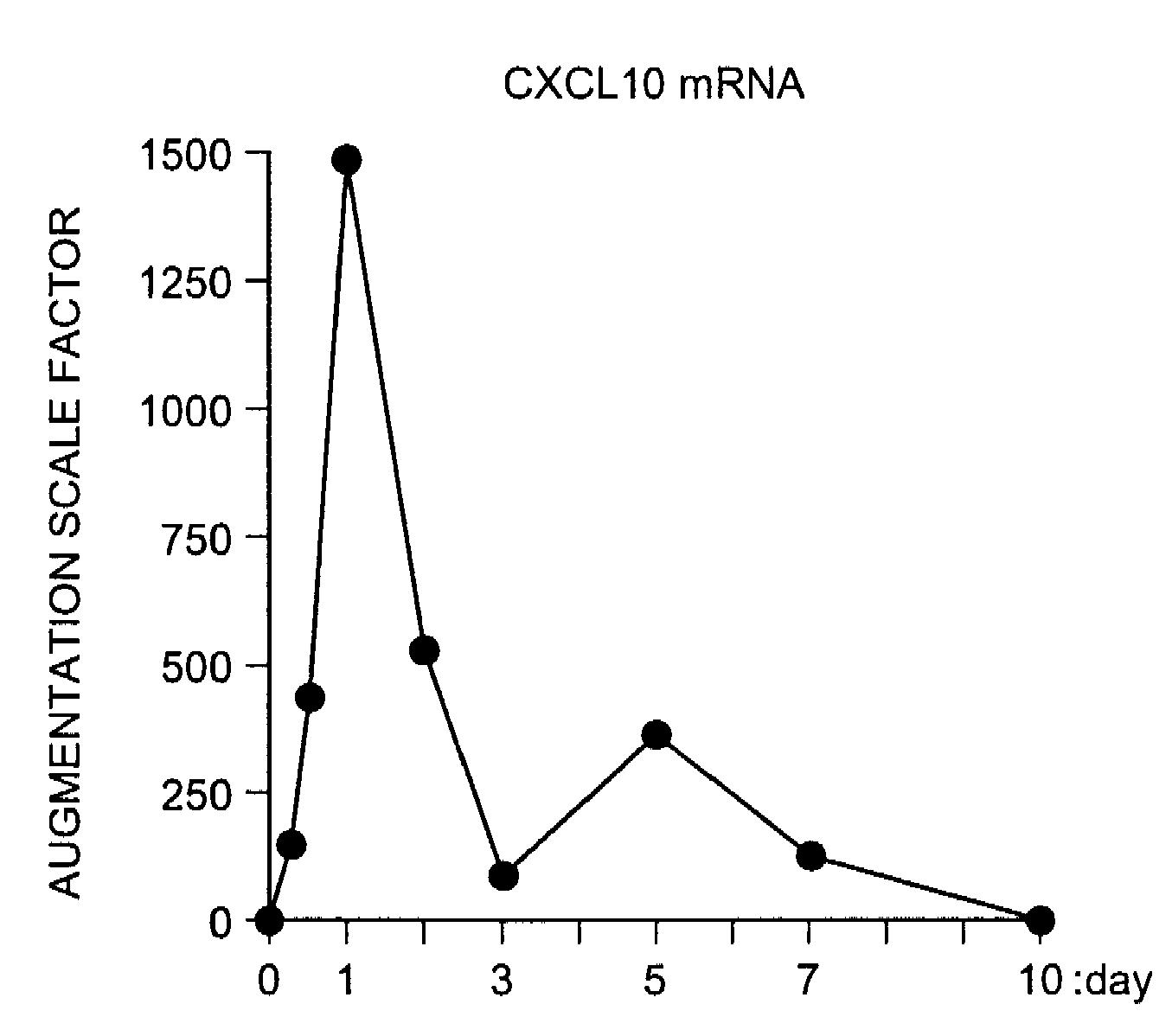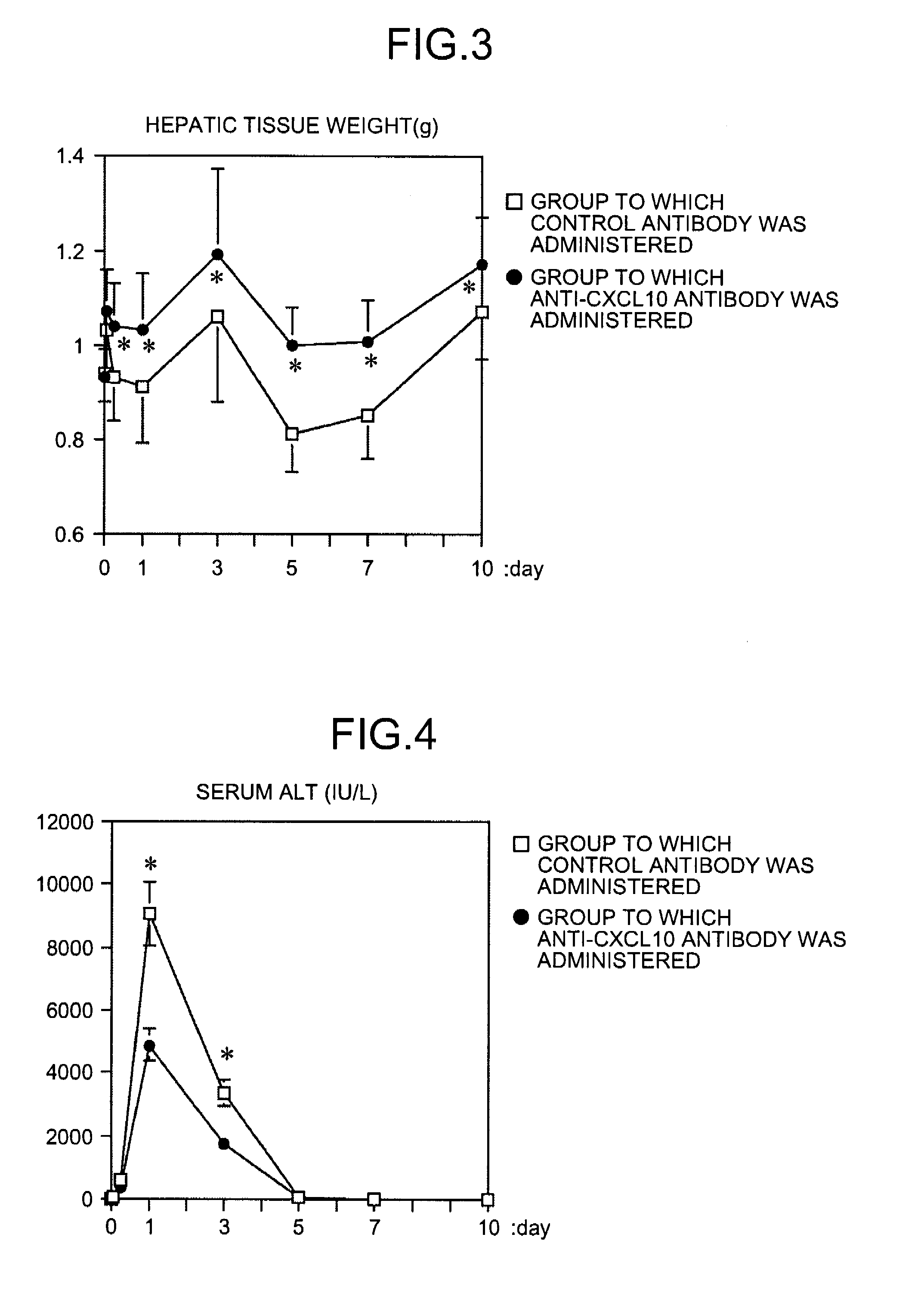Agent for promoting hepatic cell replication and agent for improving insulin resistance
a technology of hepatic cell replication and promoter, which is applied in the direction of peptides, drug compositions, metabolic disorders, etc., can solve the problems of high mortality of patients with acute hepatic failure due to a hepatocyte disorder, life-threatening severe state of a living body, and the risk of infection, so as to promote the replication of hepatocytes and improve insulin resistance.
- Summary
- Abstract
- Description
- Claims
- Application Information
AI Technical Summary
Benefits of technology
Problems solved by technology
Method used
Image
Examples
example 1
Augmentation of CXCL10 Expression in Impaired Hepatocytes Using Carbon Tetrachloride Induced Hepatic Disorder Model
[0112]The expression of CXCL10 was evaluated using the carbon tetrachloride induced hepatic disorder model. The carbon tetrachloride induced hepatic disorder model was constructed in accordance with the description in Morrison GR. Arch. Biochem. Biophys. 111:448, 1965. Because of no infiltration of Th1 cells in this hepatic disorder model, the effect of CXCL10 on Th1 cells can be ruled out. Thus, this model has an advantage that replication and regeneration of hepatocytes in vivo may be purely evaluated. The nucleotide sequence of CXCL10 has been already registered in database such as DDBJ (DNA Data Bank of Japan). The CXCL10 protein and the anti-CXCL10 antibody are commercially available products.
[0113]Carbon tetrachloride (CCl4, 0.5 μL / g body weight supplied from Sigma Aldrich) was intraperitoneally injected into C57BL6 / J mice (female, 8 to 9 weeks of age supplied fro...
example 2
[0117]For the purpose of analyzing whether the augmentation of CXCL10 expression is beneficial or harmful for the living body, 100 μg of a monoclonal anti-CXCL10 antibody (suspended in 200 μL of sterile PBS) was once injected into a tail vein of C57BL6 / J mice (female, 8 weeks of age, supplied from CLEA Japan Inc.) just before administering CCl4. The monoclonal antibody used in this study is specific for CXCL10 and exhibits no immunological cross reactivity with CXCL9 and CXCL11 which are other ligands of its receptor CXCR3. As its neutralization activity, the monoclonal antibody inhibits chemotaxis of CXCR3 positive activated T lymphocytes. The mice were sacrificed with time, and clinical findings were compared with those in the mice treated with a control antibody.
[0118]The monoclonal antibody was prepared using methods well-known in the art and used commonly. A peptide portion of the CXCL10 protein for use as an immunogen was determined by the method well-known in the art, and a r...
example 3
[0123]Just before administering CCl4, 100 μg of the monoclonal anti-CXCL10 antibody (suspended in 200 μL of sterile PBS) or the control antibody was once injected into the tail vein of C57BL6 / J mice (female, 8 weeks of age, supplied from CLEA Japan Inc.). The mice were sacrificed with time, and histological pathological findings were compared with those in the group treated with the control antibody. Frozen sections of the liver were prepared by the method described in Example 1, and analyzed immunohistologically. As a primary antibody, a rat anti-murine CD31 monoclonal antibody (2 μg / mL, supplied from PharMingen) or a rabbit anti-murine collagen type IV polyclonal antibody (diluted at 1:250, supplied from Sigma) was reacted at room temperature for one hour. Subsequently, alkaline phosphatase-labeled anti rat or rabbit IgG (diluted at 1:200, supplied from Jackson ImmunoResearch) was reacted at room temperature for one hour. The binding of the antibody was visualized under an optical...
PUM
| Property | Measurement | Unit |
|---|---|---|
| concentration | aaaaa | aaaaa |
| concentration | aaaaa | aaaaa |
| concentration | aaaaa | aaaaa |
Abstract
Description
Claims
Application Information
 Login to View More
Login to View More - R&D
- Intellectual Property
- Life Sciences
- Materials
- Tech Scout
- Unparalleled Data Quality
- Higher Quality Content
- 60% Fewer Hallucinations
Browse by: Latest US Patents, China's latest patents, Technical Efficacy Thesaurus, Application Domain, Technology Topic, Popular Technical Reports.
© 2025 PatSnap. All rights reserved.Legal|Privacy policy|Modern Slavery Act Transparency Statement|Sitemap|About US| Contact US: help@patsnap.com



